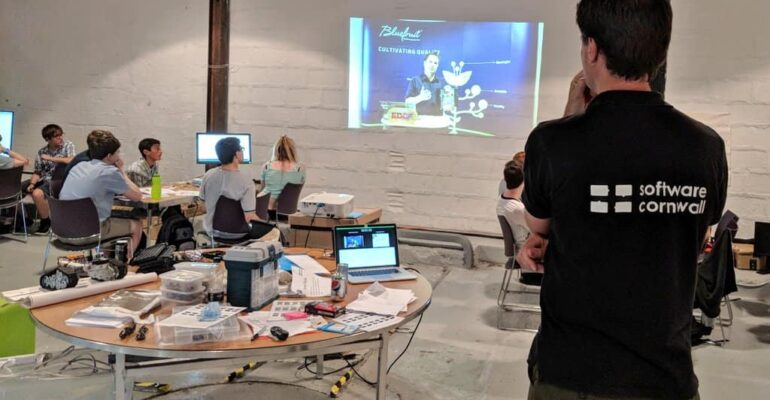This post was contributed by Team E, a startup team from the 2018 Mission to Mars Work Experience program.
Hi! We’re Abby McAuliffe, Laurie Harbord, Cam Loughlin and Kyle Doody. We participated in the recent Mission To Mars Work Experience (9th – 13th July), hosted at Heartlands in Pool, and loved it!
As Team E we worked together to program our rover (who we rather loudly renamed ‘Florence’) to perform a series of tasks. With quite some success!
The challenges build upon each other, which developed our understanding and knowledge of the code we were using. Saying that, different ‘stories’ do require new uses of and outright new code. As we started with the most basic code, it didn’t matter if we had lots of programming experience or none.
Not only were we learning new code but Mission To Mars is also a brilliant chance to meet other people with similar interests; learn more about the tech industry and develop other skills such as communication and problem-solving. There’s even some hardware involved as we often use breadboards as prototypes to test-run code. Our team have gotten along brilliantly and have determined to stay in contact after the event itself. I know several others are also doing the same. Being in a room with so many other people with at least some shared interests is really comforting and lessons that initial ‘Oh God’ feeling of walking into a place likely full of strangers.
Each day followed the same basic structure, with introductions and basic information beginning the week and a series of small presentations given by the teams at the end. (The latter actually wasn’t as scary as it seems!) We’d spend the majority of the day coding and testing our program so far. We collaborated within our teams and even with others from rival groups. The atmosphere is really inclusive and there’s a buzz to the air – we loved that about it.
As well as the actual coding and the essential lunchtime, we also took part in Agile activities to help build communication, teamwork and problem-solving abilities. For example, ‘Scrum Tennis’ promoted teamwork and problem-solving as we had to work together to get as many tennis balls past around the group within two minutes as possible. Sounds a little odd, we know, but it was really fun and the competitive element motivated us no end.
Another activity had us trying a number of production methods for paper airplanes that had to hit the far wall. This undoubtedly sounds even weirder, but it really showed us how working together and understanding each other’s capabilities was useful and allowed us to maximise our productivity. And paper planes are always a laugh!
A straight fact for Mission To Mars: you will enjoy it. You may arrive nervous and insecure in both yourself and your programming, but you will be surrounded by like-minded friends and become more confident in programming, both individually and in groups. Don’t debate whether you want to do it: just fill out an application now. Or next time. Or the time after that. When you do you will have a week you will never forget, for all the best reasons. It’s fun, hard and you make friends who are actually like you. (Plus you can go to Tesco.)
The actual tasks – called ‘stories’ – cover a range of movements and techy elements of the rover. From LEDs to straight lines (just a warning: that one’s a bit of a nightmare and probably the most satisfying because of it) and figure of eights to light sensors, there’s a lot of variety in the main series of challenges, and they do get progressively harder, though the odd one in the middle is particularly frustrating. Some we brute-forced (just continually tested, with small adjustments to the code, based more off of the physical movements than the code itself) and others we only had to program once or twice to get right on the rover.
Story 6 kept us stuck for a day and a bit – but that beat my (Abby’s) previous record by a day. Most teams, and all of those this time, spend at least a day on Story 6. Getting the rover to drive in a straight two-metre long line is deceptively difficult!
The breadboard circuits were great for preliminary testing, so we didn’t waste ‘core coins’ (the currency used for Mission To Mars) by using the rover. In the end, we completed eight of the eighteen-odd tasks, plus three of the bonus challenges such as effective commenting on code, leaving us pretty high in the rankings, we came second with over 50,000 coins.
All in all, the four of us had an educational and enjoyable time at our Work Experience and fully intend to come again. And so with thanks to Tony, Robert and everyone else, we give our massive recommendation for Mission To Mars. It’s a brilliant experience!

